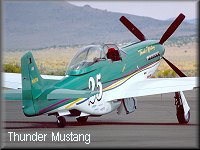 |
"Thunder
Mustang" Update - Initial NTSB
Findings
 The
following are quotes from the National Transportation
Safety Board preliminary finding on the investigation of
the Thunder Mustang accident. The
following are quotes from the National Transportation
Safety Board preliminary finding on the investigation of
the Thunder Mustang accident.May 30, 1998 At approximately 1230 mountain daylight time, an experimental PAPA 51 Thunder Mustang, N151TM, impacted the terrain about six miles south of Marsing, Idaho. The commercial pilot and his passenger, who held a private pilot certificate, both received fatal injuries, and the aircraft was destroyed. The personal pleasure flight, which was being conducted to demonstrate the performance capabilities of the aircraft to the private pilot, departed Nampa Municipal Airport, Nampa, Idaho, about 25 minutes prior to the accident. No flight plan had been filed, and according to witnesses, the aircraft was being operated in visual meteorological conditions. The ELT had been removed for repair. According to witnesses, the aircraft had been maneuvering in the general area for a little over five minutes prior to the crash. The witnesses reported that part of the time, they could hear the aircraft's engine running strong and smooth, but that there were also times when it sounded like it was popping and backfiring or not running at all. Most witnesses said that during the descent which culminated in impact with the terrain, the aircraft's engine could not be heard at all. June 8, 1998 As of this date, the NTSB is continuing its investigation of the Papa 51 Thunder Mustang accident that occurred near Marsing, Idaho, on May 30, 1998. The investigative team is made up of the NTSB Investigator-In-Charge (IIC), an FAA Airworthiness Inspector, an FAA Operations Inspector, two representatives from Papa 51 Corporation, and a representative from Falconer Industries, the manufacturer of the engine. To this point, the team has reviewed numerous written witness statements, and has contacted some of the witnesses by phone in order to acquire a more detailed description of what these individuals saw and heard. Also, arrangements are being made to take two of the witnesses back to the locations where they were at the time they saw the events leading up to the crash. Further interviews will take place at that time. In addition, the team has finished a total disassembly of the Falconer V-12 engine. The engine tear down inspection included components from the fuel supply and fuel injection system, the air induction system, the oil filter and supply system, each gear in the engine-to-propeller reduction gear box, the rocker/push rod/valve assemblies, the piston/ring/connecting rod assembly, as well as the camshaft, crankshaft, and all associated bearings. As part of the engine tear down inspection, the team was able to retrieve data-logged engine and propeller performance information from one of the aircraft's Motec Engine Control Unites (ECU). The team was able to print out this data at one second intervals from the time of engine start until the aircraft impacted the terrain. This data has undergone an initial review and is being further analyzed at this time. No data has been recovered from the aircraft's other ECU because of damage to its circuit board, but the ECU's manufacturer believes that it is likely that data may be able to be recovered later this week. Following the engine inspection, the team completed
its initial reconstructive-mockup of the airframe.
Although some components had sustained substantial damage
and some carbon fiber structure had partially burned, all
major structural components and system components Although all aspects of the investigation, including the engine and airframe, are still ongoing, to this point, no evidence has been found that would indicate a malfunction with the engine or its accessories, nor has any pre-impact irregularity been found in the airframe. In addition to the expanded witness interviews, the team is in the process of acquiring radar data from both Salt Lake Center and Mountain Home Air Force Base that may provide additional ground tract and airspeed information. News Release Papa 51 NTSB ISSUES INVESTIGATIVE REPORT Nampa, IS - The NTSB has provided an investigative update of the Thunder Mustang crash. Their report said: "Although all aspects of the investigation, including the engine and airframe, are still ongoing, to this point, no evidence has been found that would indicate a malfunction with the engine or its accessories, nor has any pre-impact irregularity been found in the airframe." The investigation has involved members of the NTSB, FAA, Papa 51 Company and Ryan Falconer of Falconer Engines. 'There has been a lot of speculation on the internet about what may have happened,' said Dan Denney, President of Papa 51, Ltd. ' Most of the theories are based on misinformation and conjecture, rather than fact. We've been very impressed with the approach taken by the NTSB and the FAA in this matter. They are very thorough and deliberate.' AAFO will update this story as more facts become available. |